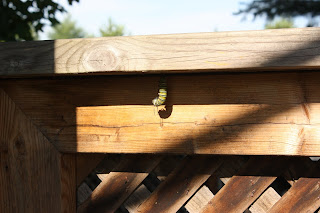Yesterday I noticed a rather large caterpillar on the clothes line. I moved it to the deck railing and let it move on from there. Imagine my surprise this morning to see it underneath the railing, hanging from the rear end of its body.
I googled monarch butterflies, because I had an intuition that this is what this was. And sure enough, there was a photo of a caterpillar just like this one. So this is the fourth stage of the life cycle, and now the caterpillar spins a pad of sticky stuff to which it then hangs. It hangs in a J-shape, with its head at the bottom. If you stay and watch, you will see the caterpillar then slough off its outer covering and spin itself into a translucent green cocoon.
I had to take the dog for a walk at this point, so I totally missed the "pupa dance" that I had heard about at the February horticultural meeting. It takes all of ten minutes, so it must be quite amazing to see this happen.
In the photo below, you can see the caterpillar has disappeared inside this green sack, which is about half the size of the caterpillar. The black fuzzy thing at top left is its skin, I presume. If you look closely, you can see the stripes that were the pattern of its skin.
Apparently, it will remain in this cocoon for about 15 days, during which time the cocoon will become transparent and you will be able to see the colour of the wings that are forming.
It is a truly amazing process and I hope to document it as it proceeds. I read that only 10% of these larva become monarch butterflies so this one has made it through 80% of the process thus far, and has a good chance of emerging in two weeks as a spectacular butterfly. Then it will live for about 2 weeks, during which time it will mate and produce another bunch of larvae that will go through the entire process again.
As for predators, the monarch butterfly tastes vile, so that is its best protection. And another amazing fact is its flying speed: 9 kilometres per hour, faster than the average jogger. All this done on the nectar and leaves of the milkweed plant growing in the field right next door. Nature is truly awesome.













































